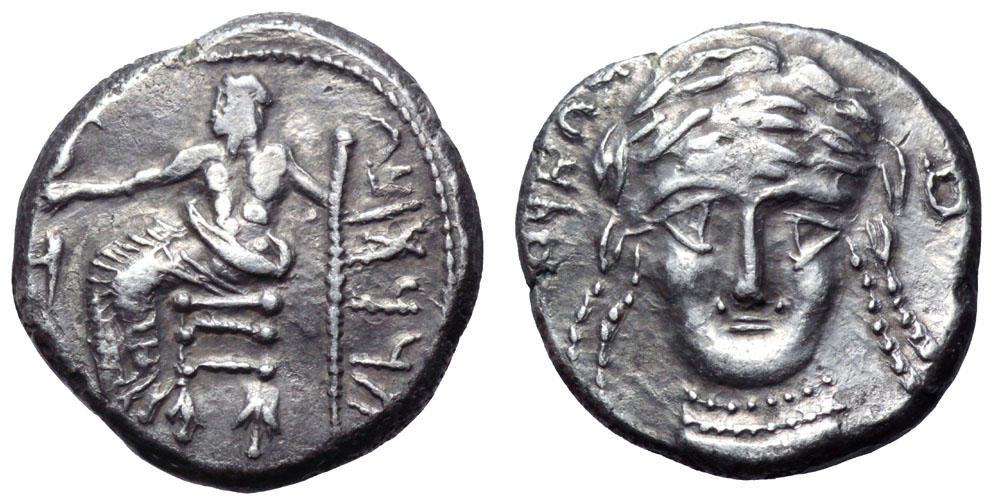S 2048 - Hierapolis-Bambyke, silver, didrachms (facing head/Baaltars) (333-323 BCE)
From SILVER
333 BCE - 323 BCE Silver 3,111 kg
Description
| ObverseInscription or printing placed on the obverse.: | Aramaic legend 'Ateh' to right (Aramaic).Zeus as Baltaars seated to left, head facing, holding sceptre and eagle, plough to left |
| ReverseInscription or printing placed on the reverse.: | Aramaic legend to left, O to right (Aramaic).Facing female head, wearing double pearl necklace |
Mint and issuing power
| MintIdentifies the place of manufacture or issue of a numismatic object.: | Hierapolis-Bambyke | Ancient regionAncient region.: | Syria | Modern countryModern country: Syria | AuthorityIdentifies the issuing power. The authority can be "pretended" when the name or the portrait of X is on the coin but he/she was not the issuing power. It can also be "uncertain" when there is no mention of X on the coin but he/she was the issuing power according to the historical sources: | Abd-Hadad of Hierapolis, Persian Empire |
Chronology
| FromIdentifies the initial date in a range assigned in a numismatic context. | 333 BCE | toIdentifies the final date in a range assigned in a numismatic context.. | 323 BCE | PeriodTime period of the numismatic object.: Classical 480-323 BC |
Physical description
| MetalThe physical material (usually metal) from which an object is made.: | Silver |
Median weightMedian of the weights of numismatic objects (in grams). in grams | 8.20 | DenominationTerm indicating the value of a numismatic object. Examples: tetradrachm, chalkous, denarius.: | didrachm |
StandardStandard.: |
Image

S2048 Bambyke head baaltars.jpg [1]
References
| Die study referencePublication of the study: | Andrade 20171Andrade 2017, p. 35-36 (Series 8-10) | ||
| Coin series referenceReference to coin series study: | |||
| Coin series web referenceCoin series web references: | |||
Obverse dies distribution
| FrequencyFrequency of specimen in distribution. ᵖ | Number of obversesNumber of obverse dies. ᵖ (o) | % (o) | Number of coinsNumber of coins. (n) | % (n) | Die nameName(s) of the die(s). |
| 1 | 5 | 83.33 | 5 | 62.5 | 8/2, 9/1, 10/1, 10/2, 10/3 |
| 3 | 1 | 16.67 | 3 | 37.5 | 8/1 |
| Total | 6 of 6 | 100 | 8 of 8 | 100 |
Reverse dies distribution
no distribution is available
Quantification
| Number of obversesNumber of obverse dies. ᵖ (o) | 6 | Number of singletons (o1)The number of singleton coins. ᵖ | 5 |
| Number of reverse diesNumber of reverse dies. (r) | 7 | Number of coinsNumber of coins. (n) | 8 |
| Coins per obverse dieNumber of coins per obverse die. (n/o) | 1.33 | Coins per reverse dieNumber of coins per reverse die. (n/r) | 1.14 |
| Reverse per obverse ratioRatio of obverse dies divided by reverse dies. (r/o) | 1.17 | Percentage of singletons (o1)number of coins (n) divided by the number of singletons (o1) ᵖ | 83.33 % |
| Original number of dies (O) (Carter 1983 formula)The estimation of the number of coins according to Carter 1983 ᵖ | 18.97 | Coins struck if 20,000 as average productivity per dieCoins made if the average productivity for obverses (according to Carter) is 20,000. ᵖ | 379,400 |
| Original number of dies (O) (Esty 2011 formula)The estimation of the number of coins according to the singleton formula in Esty 2011 ᵖ (O) | 24 | Survival rate if 20,000 as average productivity per dieSurvival rate if average productivity is 20,000. ᵖ | 0.00002 |
| Coverage (o = % of O) (Esty 1984 formula)Esty 1984 - coverage (% of O) ᵖ (o = % of O) | 37.5% | Die productivity if survival rate 1/2,000Average productivity if survival rate is 1/2,000. ᵖ | 843.44 |
| Weight of silver (in kg) if 20,000 coins per die (O = Carter formula)Carter 1983 * Median weight * 20000 (*10 if gold or electrum) ᵖ | 3,111 kg <br /> 3,111 kg | Die productivity if survival rate 1/5,000Average productivity if survival rate is 1/5,000. ᵖ | 2,108.59 |
Remarks
References
- ^ Andrade, Nathanael J. (2017), "The Silver Coinage of Syrian Manbog (Hierapolis-Bambyke)," American Journal of Numismatics, 2nd ser., 29, p. 1-46, pl. 1-5